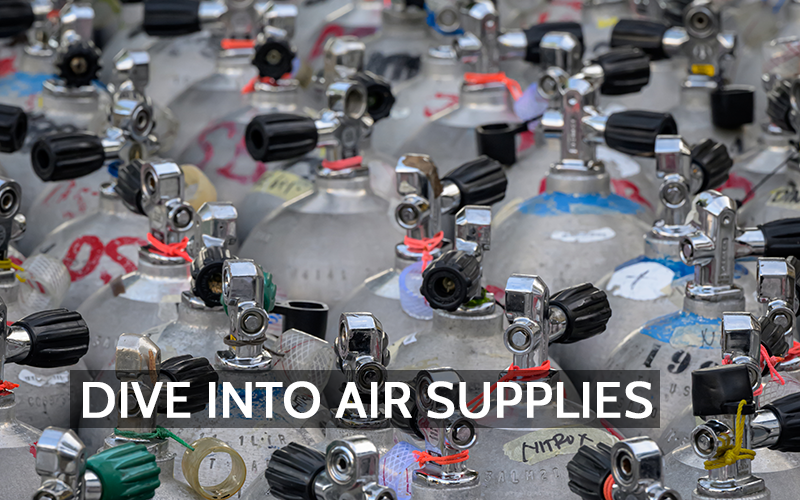When safety and survival are on the line, self-contained breathing apparatuses (SCBA) and diving rebreathers become essential tools for firefighters and divers, respectively. Though both systems aim to provide breathable air in environments where it’s unavailable, the technologies differ in design and function to suit each group’s unique needs.
Self-Contained Breathing Apparatus (SCBA) for Firefighters
Firefighters rely on SCBAs to operate in environments filled with smoke, toxic gases, or low oxygen levels. An SCBA is designed to be completely independent of the surrounding air, supplying compressed breathable air through an air cylinder, a high-pressure regulator, and a face mask. This closed system ensures that firefighters remain protected from inhaling hazardous particles and gases while still receiving ample air to perform physically demanding tasks.
- High-Pressure Air Cylinder: Firefighter SCBAs are fitted with high-pressure air cylinders, typically holding 30 to 60 minutes of compressed air at pressures up to 4,500 psi. The air in the cylinder is reduced in pressure as it moves through the regulator, allowing firefighters to breathe comfortably through a face mask.
- Face Mask and Pressure Demand: SCBAs use a face mask that creates a tight seal, preventing contaminated air from entering. The pressure-demand system provides breathable air only when the firefighter inhales, conserving air during moments of low activity.
- Built-in Alarms and Safety Features: Modern SCBAs include a personal alert safety system (PASS), which triggers an alarm if the firefighter stops moving for a certain period, alerting others to a potential emergency.
Rebreathers for Divers
Divers working underwater often use rebreathers, which allow for longer and quieter dives compared to traditional SCUBA systems. Unlike SCBAs, rebreathers recycle exhaled air by removing carbon dioxide and adding oxygen, a process that minimizes the release of bubbles into the water, which is especially useful for scientific, military, or deep-sea exploration.
- Closed-Circuit System: Rebreathers operate on a closed circuit, meaning they recirculate exhaled gas instead of releasing it. The system uses a scrubber to remove carbon dioxide, while oxygen is added as needed to maintain a breathable air mix.
- Oxygen Monitoring and CO₂ Scrubbing: Rebreathers require constant monitoring of oxygen levels. Divers use sensors and displays that alert them to any changes in oxygen levels, while a scrubber removes carbon dioxide to prevent buildup. This scrubbing is essential to prevent CO₂ toxicity, which can lead to unconsciousness if unmanaged.
- Extended Dive Times and Silent Operation: Because rebreathers recycle air, they extend underwater time significantly. Additionally, they allow divers to move silently, an advantage for wildlife studies or covert military operations.
Key Differences Between SCBAs and Rebreathers
While both SCBAs and rebreathers serve the purpose of providing breathable air, their design and operational priorities differ:
- Air Supply: SCBAs rely on a fixed air supply in high-pressure cylinders, which limits their duration to the air tank’s capacity. In contrast, rebreathers continuously recycle air, adding oxygen as needed, which allows for longer operational times.
- Environment-Specific Design: SCBAs are built to withstand high temperatures and exposure to smoke and chemicals in fire-prone areas, whereas rebreathers are optimized for underwater environments, where managing buoyancy and oxygen levels is critical.
- Safety Considerations: SCBAs include safety features like the PASS alarm to help locate firefighters in distress. Rebreathers, however, demand vigilant monitoring of oxygen and carbon dioxide levels to prevent the risk of hypoxia (lack of oxygen) or hypercapnia (too much carbon dioxide in the blood) underwater.
How These Systems Work
SCBAs are built around simplicity and reliability, designed to deliver breathable air in high-risk environments. The face mask, regulator, and cylinder work in tandem to deliver clean air on-demand, ensuring a steady supply even under extreme conditions. Firefighters can rely on a system with few complex components, enhancing their ability to operate swiftly and effectively.
Rebreathers, on the other hand, integrate advanced oxygen sensors, scrubbers, and alarms to create a delicate balance of gases, particularly important for deep-sea divers. The system’s closed-loop design provides stealth and efficiency, but it also requires the diver to be well-trained in interpreting oxygen levels and maintaining the equipment.
Choosing the Right System for the Job
Understanding the specific demands of each environment is critical to selecting the right breathing system. Firefighters need equipment that offers a rapid response to emergencies, with user-friendly safety features and robust protection against heat and toxins. Divers, especially those in the military or scientific fields, benefit from the quiet, extended endurance that rebreathers provide, enabling them to carry out complex tasks while managing buoyancy and minimizing disturbances in aquatic habitats.
Both SCBAs and rebreathers exemplify the evolution of breathing technology, tailored to meet the diverse and challenging needs of life-threatening situations on land and underwater.


